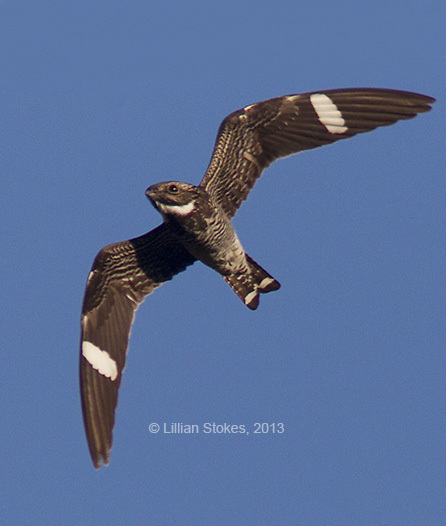Lillian Q. Stokes's Blog
October 10, 2025
RIP Don Stokes 2/21/47 - 10/7/25
 Don Stokes
Don Stokes 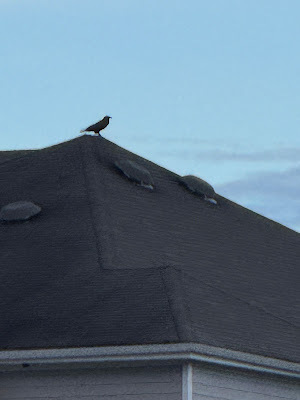
The Raven that flew over me
10/7/25 - On a beautiful October day, after a harvest-full-moon-Great-Horned-Owls-calling night, my beloved husband, Don, age 78, died, then a Raven flew over my head.
After a long 9-year decline, Don died of Lewy Body Dementia in a dementia facility he had been in for three plus years. I was with him in the afternoon, and even though he was unconscious, I think he heard me when I asked for two things: that he wait to die until my daughter got there (she did, and my son had visited in the morning) and that he send me a Raven, his favorite bird, after he died. After I had visited him, I had to run an errand, and my daughter, who was with him, then called to say he was gone. I drove back, and when I pulled into the parking lot and got out of the car, a Raven swooped down, flew low right over my head, and landed briefly on a nearby building, and then was gone. Rest in peace, Don, may you fly with the Ravens.
You all know him as a loving, kind, humorous, gifted teacher and deeply spiritually connected to nature. In place of a formal obit, let me tell you some things about Don you may or may not know.
Don was born in Philadelphia into a Quaker family and went to Germantown Friends School, then Swarthmore College, majoring in Comparative Religions. He was a talented musician who could sing, play the piano, and was an excellent tabla hand drum player. He even spent time in Calcutta, India, studying with a tabla guru there.
After college, Don moved to Berkeley, California, and in the hills kept careful and beautiful journals of the nature he encountered. He soon realized he was seeing things that little was known about. That planted the seed that later led him to begin writing about nature. After returning to Massachusetts, he taught at the Warehouse Cooperative School, where he met Bill Phillips, an editor at Little, Brown and Company/Hachette, whose daughter attended the school. Bill accepted Don's first book, Nature in Winter, and went on to become Don's editor for many years.
Don then began teaching at the Massachusetts Audubon Society and was in the process of writing a bird behavior guide when he met Lillian (already an avid hawk-watcher who came from a background in animal behavior and psychiatric social work), who took his course on Bird Behavior. As they say, the rest is history. Don and Lillian got married and over more than 30 years produced 35 Stokes Guides, including 3 volumes on bird behavior (instrumental in introducing a holistic approach to birds), backyard books such as the Bird Feeder, Hummingbird, and Bluebird books, beginner's guides, and the national The Stokes Field Guide to Birds of North America. Stokes' books have sold over 6 million copies. Don and Lillian produced and hosted the first PBS national television series on birds, Birdwatch with Don and Lillian Stokes, as well as Stokes Birds at Home, which 40 million viewers saw. They gave keynote talks and taught at birding festivals and Audubon societies across the country for years. They spent many winters on Sanibel Island birding and teaching others at Ding Darling National Wildlife Refuge through their Stokes Birding and Photography tours.They were Duck Stamp Judges and received a Partners in Flight National Conservation Award. Don belonged to many nature and conservation organizations, including the Nuttall Ornithological Club.
Befitting his beautiful, spiritual side, Don was a student of Haiku poetry, writing it for many years. Here is a fitting example.
Entering the wilds
Equipped to look at nature –
Wait! I am nature.
\Don will be buried at Mt. Auburn Cemetery in MA (a famous birding hotspot) on Goldfinch Path (how fitting!!). There will be a private family Celebration of Life as per his wishes. If you would like to do something in remembrance of Don, send a contribution to the nature, birding, or conservation organization of your choice. Thank you.
September 25, 2025
American Avocet, Birding Parker River National Wildlife Refuge!
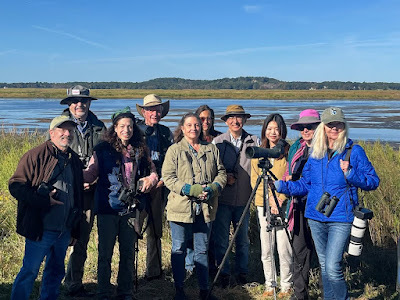
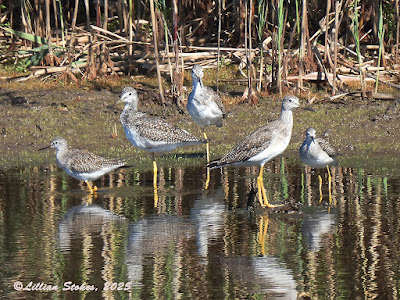 Greater and Lesser Yellowlegs
Greater and Lesser Yellowlegs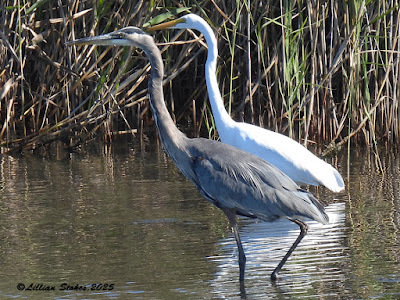 Great Blue Heron and Great Egret
Great Blue Heron and Great Egret
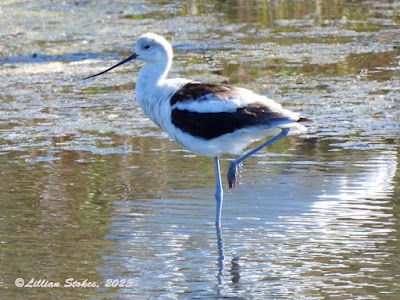 American Avocet Had a great day co-leading a Spark Birding group at Parker River NWR with Peter Alden, Saturday. There were lots of migrating shorebirds, herons and the surprise unusual species for there was an American Avocet! The SparkBirding.com bird walks are for beginning and intermediate birders. I love teaching beginners!
American Avocet Had a great day co-leading a Spark Birding group at Parker River NWR with Peter Alden, Saturday. There were lots of migrating shorebirds, herons and the surprise unusual species for there was an American Avocet! The SparkBirding.com bird walks are for beginning and intermediate birders. I love teaching beginners!August 27, 2025
Wilson's Phalarope and Migrating Shorebirds, Parker River NWR!

 Wilson's Phalarope
Wilson's Phalarope
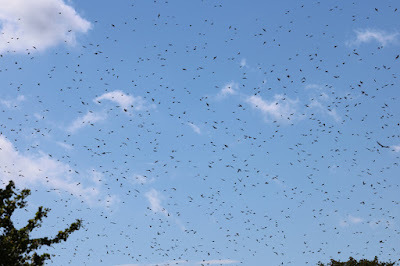 Tree Swallows
Tree Swallows
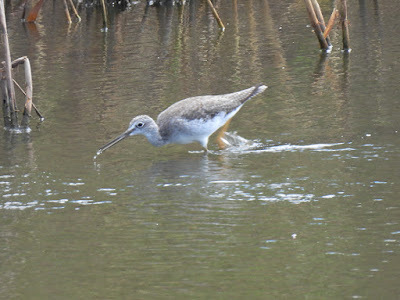 Greater Yellowlegs
Greater Yellowlegs
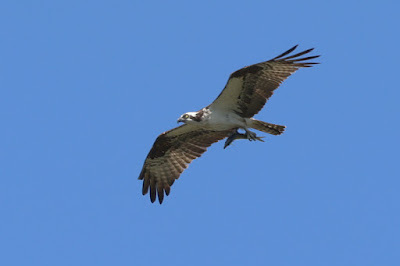 Osprey
Osprey
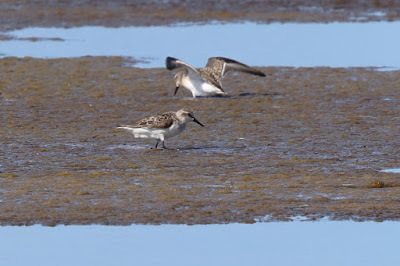 Semipalmated Sandpipers
Semipalmated Sandpipers
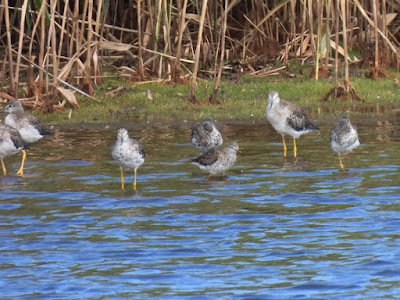 Beautiful day yesterday at Parker River NWR MA and the highlight was a Wilson's Phalarope plus clouds and clouds of many thousands of migrating Tree Swallows. The Wilson's would disappear in the reeds then dart out and race around like a Border Collie, thrilling the many birders including a group from MA Audubon and a couple of birders from Germany. There were many Semipalmated Sandpipers, Greater and a few Lesser Yellowlegs and much more.
Beautiful day yesterday at Parker River NWR MA and the highlight was a Wilson's Phalarope plus clouds and clouds of many thousands of migrating Tree Swallows. The Wilson's would disappear in the reeds then dart out and race around like a Border Collie, thrilling the many birders including a group from MA Audubon and a couple of birders from Germany. There were many Semipalmated Sandpipers, Greater and a few Lesser Yellowlegs and much more.August 21, 2025
Common Nighthawks Are Migrating!!
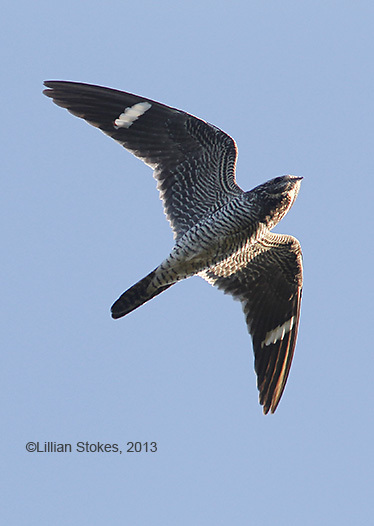 Common Nighthawk, female. Females have a buffy throat, smaller white primary bar and no tail band.
Common Nighthawk, female. Females have a buffy throat, smaller white primary bar and no tail band.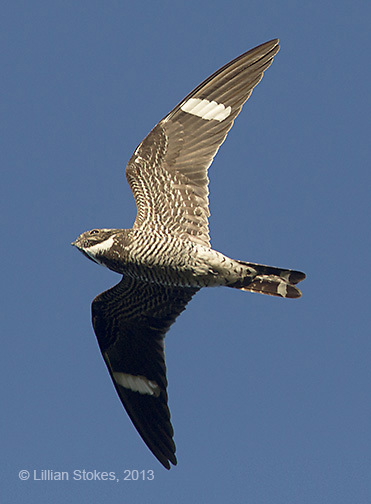 Common Nighthawk, male
Common Nighthawk, male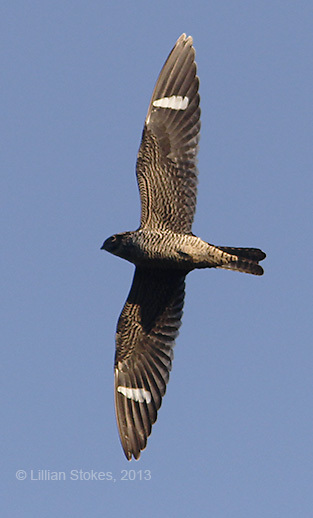 Common Nighthawk, female
Common Nighthawk, female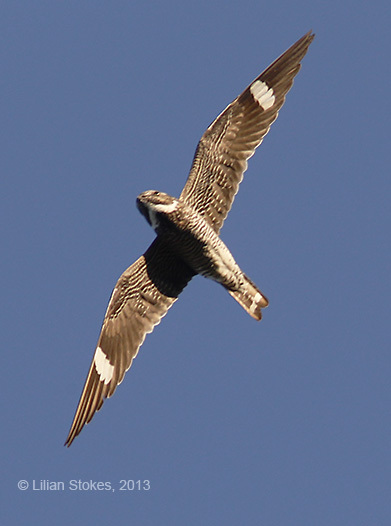 Common Nighthawk, male
Common Nighthawk, male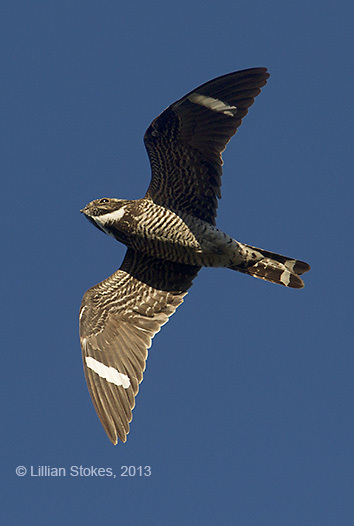 Common Nighthawk, male
Common Nighthawk, maleCommon Nighthawk migration is in full swing here in New England. Last night in NH we saw 301 from our deck. We have gotten good flights before, our previous high count has been 2,202 in one night. We live on a dammed-up section of a river, where the river flows north and nighthawks often follow river valleys on migration. We count from our deck and are often joined by our friends.
Common Nighthawk numbers have been declining in the Northeast so it was very exciting so see so many of them that night.
This is peak Common Nighthawk migration time, so get out and look. The best time to see them is at the end of the day from about 5 pm to dark.
Here are some tips for seeing migrating Common Nighthawks:
1. Look during the later afternoon to early evening hours, from about 4 pm to 7:30 pm.
2. Look north, as they generally move from north to south.
3. Get comfortable, use a chair if you can, you will be looking for quite a while. Tuck your elbows in, it is less tiring and steadier to hold binos that way.
4. Nighthawks often move along river corridors
5. Note if there is an ant hatch. Nighthawks are attracted to, and eat, dispersing ants who rise up in clouds.
6. Study the photos above, to learn nighthawk shape. Often you will only see distant birds with long pointed wings, flapping rather slowly. When feeding, nighthawks fly erratically. When migrating, they move more directly and may even rise up on a thermal sometimes.
August 8, 2025
Birds Drink Out of Humingbird Feeder Ant Moat!!
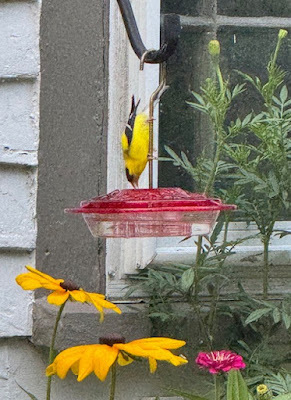
Do your yard birds do this? This American Goldfinch drinking out of the ant moat (little well of water the ants won’t cross) on the hummingbird feeder. Chickadees titmice, and House Sparrows also do this even though there are birdbaths nearby. Anyone else have birds doing this with your hummer feeders?
August 5, 2025
RARE HUMMINGBIRDS AT FEEDERS!
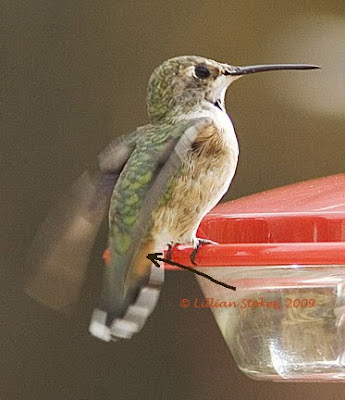 RUFOUS HUMMINGBIRD
RUFOUS HUMMINGBIRD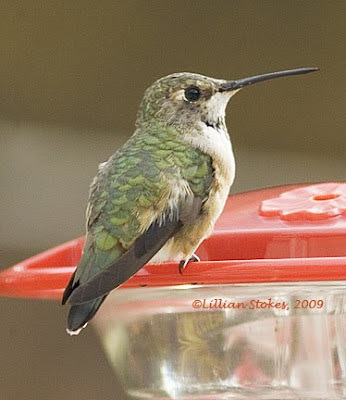 RUFOUS HUMMINGBIRD
RUFOUS HUMMINGBIRD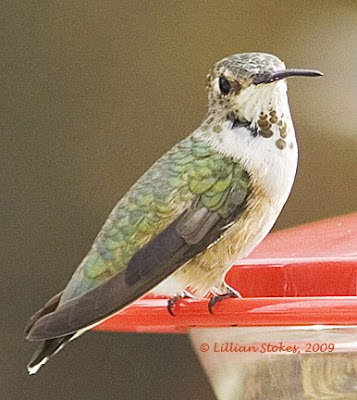 RUFOUS HUMMINGBIRD
RUFOUS HUMMINGBIRD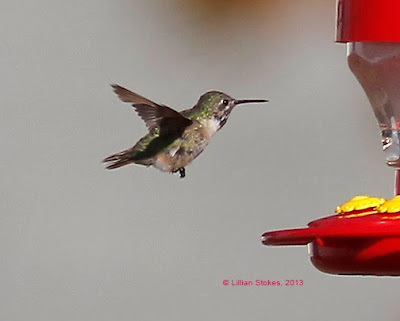 CALLIOPE HUMMINGBIRD
CALLIOPE HUMMINGBIRD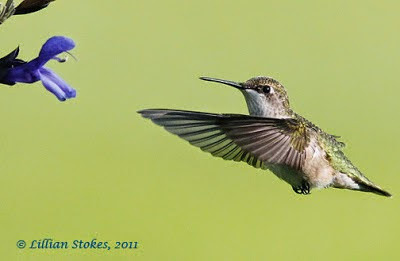 RUBY-THROATED HUMMINGBIRDThis is a great time of year, from now into fall, to look for unusual hummingbirds at your feeders in addition to the usual Rub-throated Hummingbirds whose populations swell because of the young birds. There is an increasing trend for western hummingbird species such as Rufous and Allen's hummingbirds and other's showing up outside of their normal range in fall in eastern states. Here are some photos of them from when I lived in NH. The Rufous Hummingbird (Selasphorous rufous) was visiting a feeder in Hollis, NH in Oct. 2009. This was a very unusual hummingbird for there. One was last reported in NH in 2007. The Rufous Hummingbird is a western species whose breeding range goes as far up as Alaska. Increasingly, Rufous Hummingbirds are showing up in fall in the eastern half of the country. This hummingbird was banded over the weekend and the bander reported it as a hatching year Rufous Hummingbird, sex could not be determined. Identification of female and immature hummingbirds can be tricky, especially telling Rufous from Allen's Hummingbirds. Sometimes only banders, holding them in hand, can tell them apart by subtle differences in the shape of the tail feathers and even then sometimes it is not possible to definitively tell their sex. The above photos shows the extensive rufous on the sides and rufous on the tail feathers.This little hummer is a Calliope Hummingbird, male, a bird from the Northwest who strayed far from his usual range and migration route in Nov. 2013. He came to a feeder in Manchester, NH at the home of some very gracious birders who allowed many birders to view this hummingbird, a lifer for many! This was not the first time a Calliope Hummingbird had shown up in New England and there are records from other eastern states also. Calliopes also have been reported from MA and NJ. More and more out-of-range hummingbirds are showing up in the East in fall at feeders. No one knows exactly why this occurs. Some birds' internal compasses may just direct them east instead of south. Over time that species may have a range expansion if those individuals survive and have offspring. Other people think that having more hummingbird feeders available and hardy plants in a human altered landscape may make it possible for some of these hummingbirds to be in the East in fall and winter. So keep watching your feeders!
RUBY-THROATED HUMMINGBIRDThis is a great time of year, from now into fall, to look for unusual hummingbirds at your feeders in addition to the usual Rub-throated Hummingbirds whose populations swell because of the young birds. There is an increasing trend for western hummingbird species such as Rufous and Allen's hummingbirds and other's showing up outside of their normal range in fall in eastern states. Here are some photos of them from when I lived in NH. The Rufous Hummingbird (Selasphorous rufous) was visiting a feeder in Hollis, NH in Oct. 2009. This was a very unusual hummingbird for there. One was last reported in NH in 2007. The Rufous Hummingbird is a western species whose breeding range goes as far up as Alaska. Increasingly, Rufous Hummingbirds are showing up in fall in the eastern half of the country. This hummingbird was banded over the weekend and the bander reported it as a hatching year Rufous Hummingbird, sex could not be determined. Identification of female and immature hummingbirds can be tricky, especially telling Rufous from Allen's Hummingbirds. Sometimes only banders, holding them in hand, can tell them apart by subtle differences in the shape of the tail feathers and even then sometimes it is not possible to definitively tell their sex. The above photos shows the extensive rufous on the sides and rufous on the tail feathers.This little hummer is a Calliope Hummingbird, male, a bird from the Northwest who strayed far from his usual range and migration route in Nov. 2013. He came to a feeder in Manchester, NH at the home of some very gracious birders who allowed many birders to view this hummingbird, a lifer for many! This was not the first time a Calliope Hummingbird had shown up in New England and there are records from other eastern states also. Calliopes also have been reported from MA and NJ. More and more out-of-range hummingbirds are showing up in the East in fall at feeders. No one knows exactly why this occurs. Some birds' internal compasses may just direct them east instead of south. Over time that species may have a range expansion if those individuals survive and have offspring. Other people think that having more hummingbird feeders available and hardy plants in a human altered landscape may make it possible for some of these hummingbirds to be in the East in fall and winter. So keep watching your feeders!May 22, 2025
Biggest Week in Birding May 2025
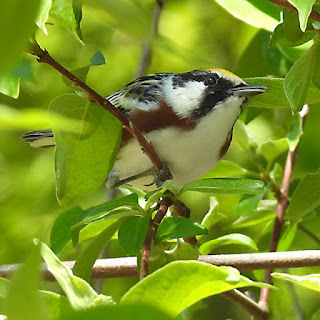 Chestnut-sided Warbler
Chestnut-sided Warbler
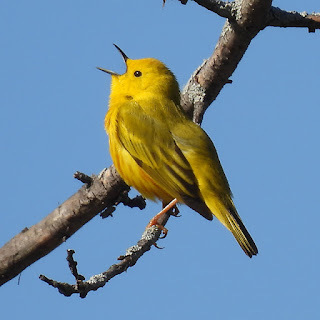 Yellow Warbler
Yellow Warbler


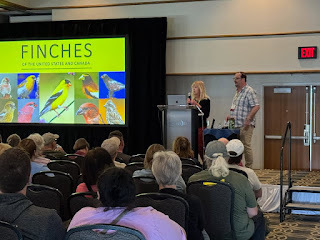 BIG!! Just got back from being keynote speaker with coauthor Matt Young at the Biggest Week in American Birding where we did a book-signing and led a Mother's Day bird walk. Big beautiful warblers, Big numbers of migrant birds, Big crowds, Big Fun, Big excitement, Big wonderful talks, Big birding talent, Big socializing! This will be a multi-day post. Our talk, based on our book, The Stokes Guide to Finches of the United States and Canada, was introduced by the wonderful Kenn Kaufman and was well received by a packed audience. Then we signed many books and I was so pleased to see some had brought their other Stokes Guides to be signed and say that my books were instrumental for getting them into birding! That is one of my biggest rewards.
BIG!! Just got back from being keynote speaker with coauthor Matt Young at the Biggest Week in American Birding where we did a book-signing and led a Mother's Day bird walk. Big beautiful warblers, Big numbers of migrant birds, Big crowds, Big Fun, Big excitement, Big wonderful talks, Big birding talent, Big socializing! This will be a multi-day post. Our talk, based on our book, The Stokes Guide to Finches of the United States and Canada, was introduced by the wonderful Kenn Kaufman and was well received by a packed audience. Then we signed many books and I was so pleased to see some had brought their other Stokes Guides to be signed and say that my books were instrumental for getting them into birding! That is one of my biggest rewards.April 11, 2025
Swainson's Warbler, Yes!
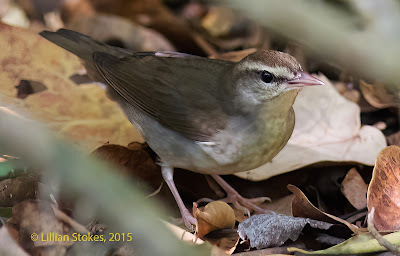
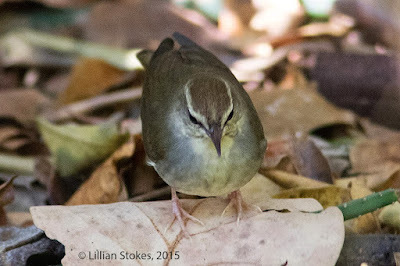
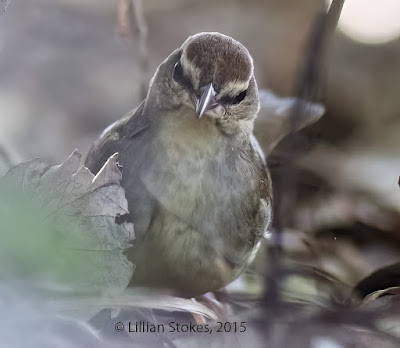
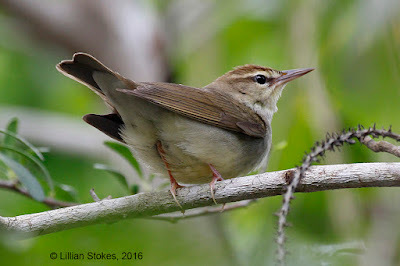 Fondly remembering Swainson's Warbler, a hard-to-see grail warbler, that I saw a number of times during fallout on Sanibel Island. This skulking, understory warbler breeds in southern swamps and wooded ravines. Given it lurks in the understory I was on my stomach for one of these photos! Hope a lot of you see it during migration.
Fondly remembering Swainson's Warbler, a hard-to-see grail warbler, that I saw a number of times during fallout on Sanibel Island. This skulking, understory warbler breeds in southern swamps and wooded ravines. Given it lurks in the understory I was on my stomach for one of these photos! Hope a lot of you see it during migration.March 30, 2025
The Red-tailed Hawk Project unraveling mysteries of the Red-tailed Hawk
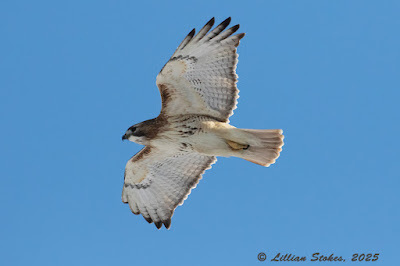
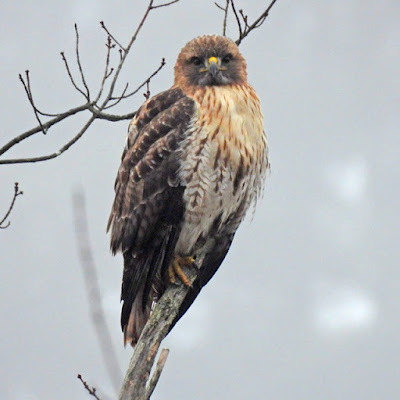
 Next time you see a Red-tailed Hawk look twice! Ponder that there are still mysteries about this common species that when solved will lead us to a greater understanding of its many plumage colors (there are 16 subspecies and some are polymorphic), genetic and ecological associations and even to a better understanding of the dynamics of avian evolution. See this great article by Scott Weidensaul on The Red-tailed Hawk Project a large research collaboration that is working to unravel the mysteries of this abundant raptor. My photos in winter show two different eastern subspecies. Top photo is the Buteo jamaicencis borealis subspecies with a white throat, chest and moderate belly band. The next two birds are the abieticola subspecies with a dark throat, colorful rusty chest and belly band with heavy dark blobs. The Red-tailed Hawk Project is cautiously examining and classifying what are the subspecies. It will be exciting to see what their research comes up with. https://www.allaboutbirds.org/.../red-tailed-hawk.../
Next time you see a Red-tailed Hawk look twice! Ponder that there are still mysteries about this common species that when solved will lead us to a greater understanding of its many plumage colors (there are 16 subspecies and some are polymorphic), genetic and ecological associations and even to a better understanding of the dynamics of avian evolution. See this great article by Scott Weidensaul on The Red-tailed Hawk Project a large research collaboration that is working to unravel the mysteries of this abundant raptor. My photos in winter show two different eastern subspecies. Top photo is the Buteo jamaicencis borealis subspecies with a white throat, chest and moderate belly band. The next two birds are the abieticola subspecies with a dark throat, colorful rusty chest and belly band with heavy dark blobs. The Red-tailed Hawk Project is cautiously examining and classifying what are the subspecies. It will be exciting to see what their research comes up with. https://www.allaboutbirds.org/.../red-tailed-hawk.../March 21, 2025
WOODCOCKS ARE DISPLAYING NOW!
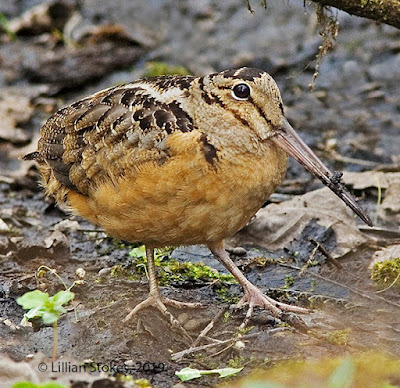 "Peent" last night heard (they are hard to see in the dark) an American Woodcock displaying to attract a mate. Woodcock males walk around open areas in the eastern part of the country at dusk "peenting" then launch into an amazing aerial display in which they can spiral up 300 feet, wings creating a chirping sound, then land and continue "peenting." Females come to the display grounds, choose a mate then go into the woods, nest on the ground, and raise the young themselves. Go listen at dusk near open field areas near woods. Woodcocks use that long bill to probe for earthworms in the mud eyes perched atop their head provide surround sight to look for predators. Woodcocks are truly one of the avian wonders this time of year.
"Peent" last night heard (they are hard to see in the dark) an American Woodcock displaying to attract a mate. Woodcock males walk around open areas in the eastern part of the country at dusk "peenting" then launch into an amazing aerial display in which they can spiral up 300 feet, wings creating a chirping sound, then land and continue "peenting." Females come to the display grounds, choose a mate then go into the woods, nest on the ground, and raise the young themselves. Go listen at dusk near open field areas near woods. Woodcocks use that long bill to probe for earthworms in the mud eyes perched atop their head provide surround sight to look for predators. Woodcocks are truly one of the avian wonders this time of year.Lillian Q. Stokes's Blog
- Lillian Q. Stokes's profile
- 2 followers


